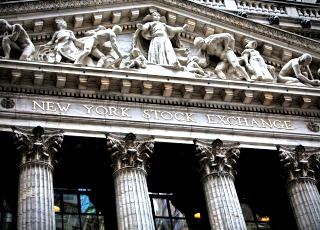Exchange (EXCH) as an organized market

The financial trading exchange was created to provide a central location for trade, making it more orderly and easier to provide a more accurate price. While most people first think of stock exchanges, such as NASDAQ or NYSE when they think of exchanges, there are other types of exchanges.
For instance, if you’re trading commodities contracts, futures or derivatives, you’d be using one of the many commodities exchanges, such as the Chicago Mercantile EXCH or one of the many parts of it including the Chicago Board of Trades.
There are also far more stock exchanges than just the two most people can identify, NASDAQ---National Association of Securities Dealers Automated Quotation System--- and NYSE---New York Stock EXCH. For instance, AMEX---American Stock EXCH, OTC Bulletin Board---Over the Counter, PHLX---Philadelphia Stock EXCH and Pink Sheets. These are just exchanges in the US. You also have the organized market in other countries, such as the Tokyo Stock EXCH, London Stock EXCH, and Hong Kong Stock EXCH. Some companies are cross-listed, meaning they’re on more than one EXCH. That allows traders to buy or sell at any time of the day or night. It also may mean getting a better bargain or selling a stock for a higher price.
Trading exchange characteristics
While trading on foreign EXCH can be exciting, most people use two, possibly three EXCH for all their stock trades. NYSE is probably the most notable one, even though it’s not the oldest trading house. That honor goes to the Philadelphia Stock EXCH, now known as NASDAQ OMX PHLX, which started in 1790. The NYSE is the largest EXCH in the world, not just in the US, so you can understand why it’s so well known. It originated with just 24 brokers who signed an agreement for a base commission rate and to give preferential treatment to each other. At that time, it dealt with all types of financial trades, including war bonds for the Revolutionary War. While the organized markets have grown and changed, it still operates in an auction style of trading. Nasdaq was started much later, in 1971.
The auction style of trade is quite different from the way that NASDAQ operates, even though the results are the same and matter little to the average investor. NASDAQ is a dealer market, not an auction market like NYSE. In an auction market, the trades are all done at one location with each person bidding on the price of the stock with the highest bid matched to the lowest asking price. The specialist facilitates the trade. The dealer style of exchange takes place all over the US via electronic means through a market maker, known as a dealer. The dealer creates the interest in the stock and will buy the stock for a specific amount and sell it for another amount. The spread between the two prices is their profit.
Most people look toward NASDAQ as the place to find newer companies, such as tech companies, whereas better-established companies are often found in the NYSE. The stocks on NASDAQ are often perceived as leaning more toward growth stocks, whereas the stocks on the NYSE are perceived as blue chip stocks that often provide stability and dividends, also to some growth. One reason for this difference of perception may be the cost to list a stock. It can be as high as $250,000 on the NYSE and only about $50,000 to $75,000 on Nasdaq. Sometimes stocks are listed on both exchanges.
Related articles
The New York Stock Exchange is expanding its digital assets and NFTs
Blockchain technology is disrupting the legacy stock exchanges
The NYSE Euronext is coining NFT tokens
Bitcoin Exchange And Trading On Coinbase Platform
AMEX - American Third Stock Exchange
The Shanghai Stock Exchange Within The Global Economy
Understanding The Moscow Exchange
About The London Stock Exchange
Frankfurt Stock Exchange
The Tokyo Stock Exchange Within The Global Economy
The Role Of The NASDAQ In Today's Global Economy
Chicago Mercantile Exchange And Understanding Commodity Exchanges
Foreign exchange trading can bring huge profits or losses
Quantitative high-frequency trading
Foreign exchange financial market
NYSE history
Exchange rates – economic review